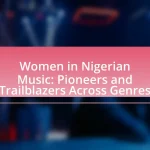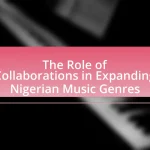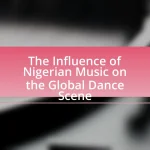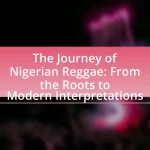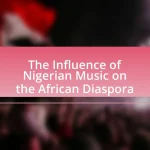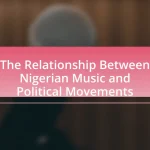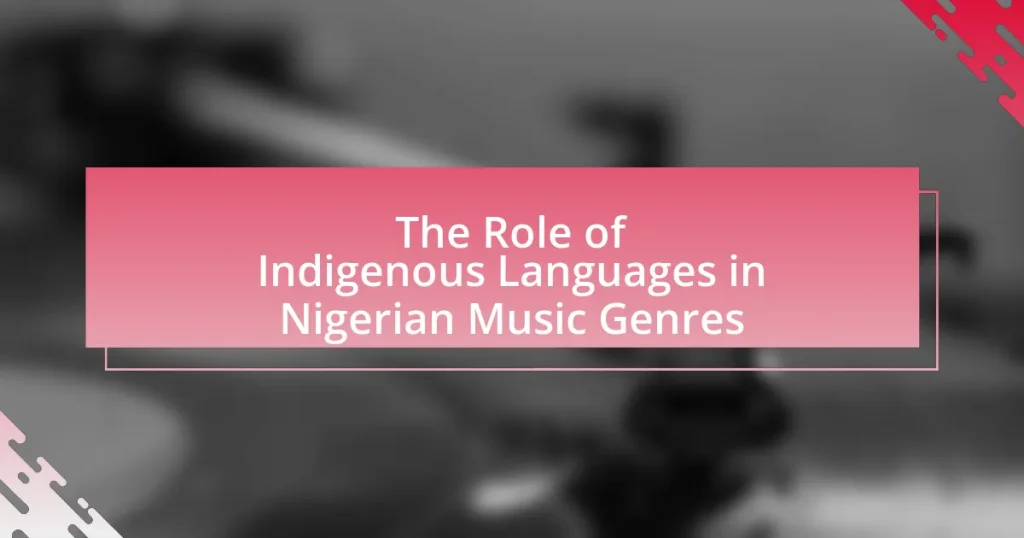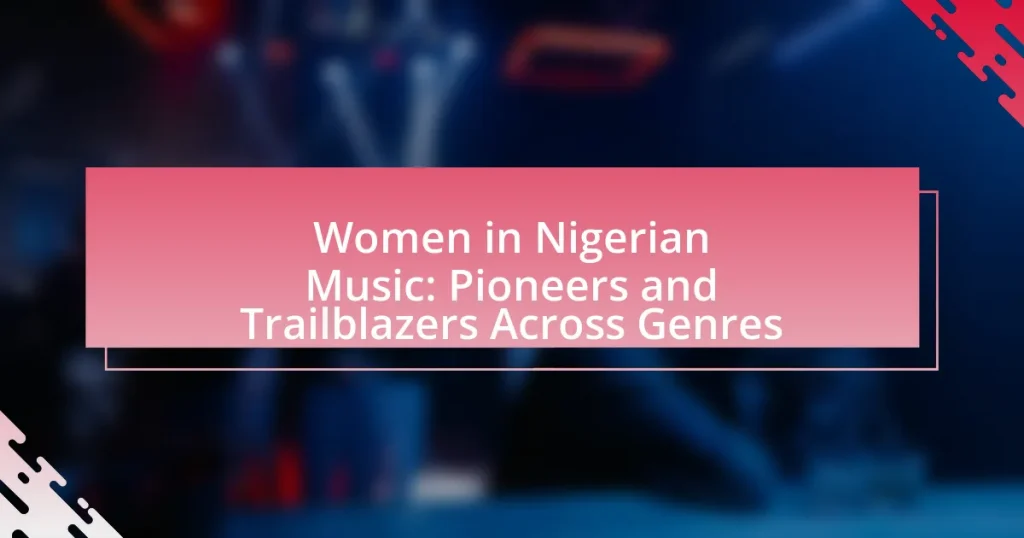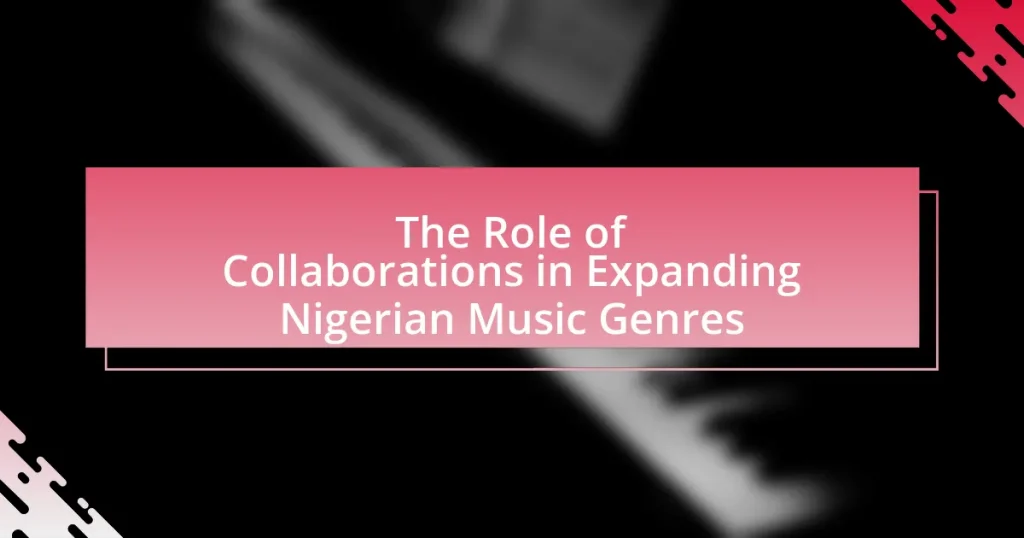The article examines the significant role of indigenous languages in Nigerian music genres, highlighting how languages such as Yoruba, Igbo, and Hausa serve as vital mediums for lyrical expression and cultural storytelling. It discusses the influence of these languages on themes within the music, including cultural identity, social issues, and spirituality, while emphasizing their importance in preserving cultural heritage and enhancing the authenticity of various genres like Afrobeat and Highlife. The article also addresses the challenges faced by indigenous languages in the music industry due to globalization and commercial pressures, as well as the efforts being made to promote these languages through technology, collaborations, and educational initiatives.
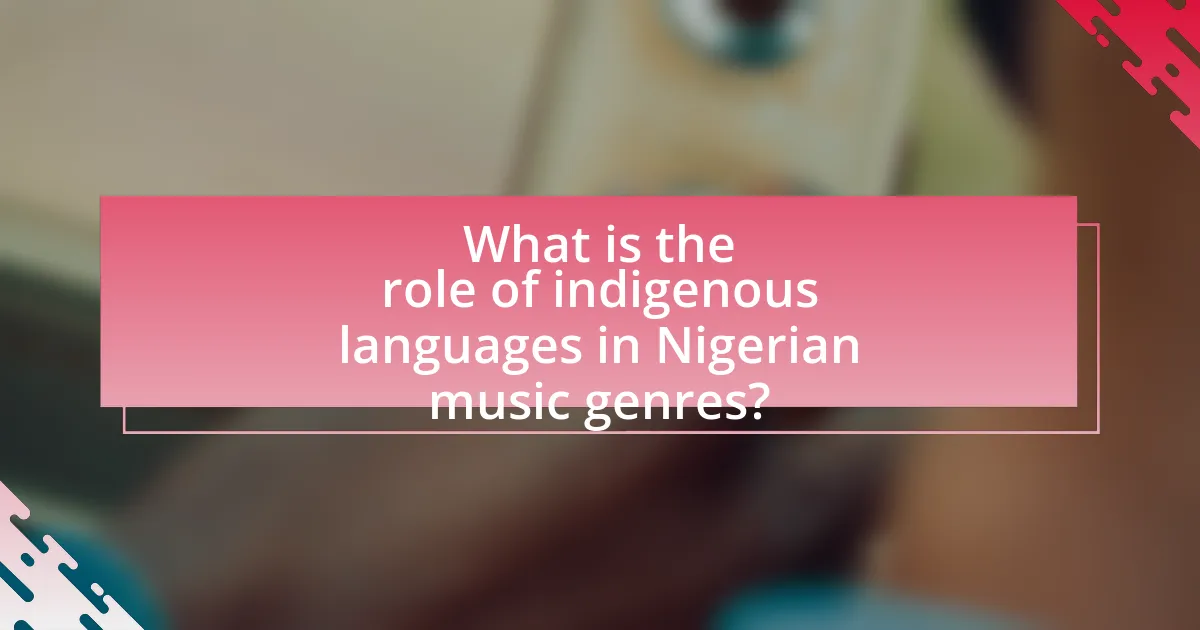
What is the role of indigenous languages in Nigerian music genres?
Indigenous languages play a crucial role in Nigerian music genres by serving as the primary medium for lyrical expression and cultural storytelling. These languages, such as Yoruba, Igbo, and Hausa, not only convey the emotional depth of the music but also preserve and promote the rich cultural heritage and traditions of various ethnic groups in Nigeria. For instance, in genres like Afrobeat and Highlife, the use of indigenous languages enhances the authenticity of the music and fosters a deeper connection with the audience, as it resonates with their cultural identity. Additionally, studies have shown that songs performed in indigenous languages often achieve greater popularity within local communities, reinforcing the significance of language in the music’s reception and impact.
How do indigenous languages influence the themes in Nigerian music?
Indigenous languages significantly influence the themes in Nigerian music by shaping lyrical content, cultural narratives, and emotional expression. For instance, songs in Yoruba, Igbo, and Hausa often reflect traditional beliefs, social issues, and historical events unique to their respective cultures. The use of indigenous languages allows artists to convey messages that resonate deeply with local audiences, as seen in the works of musicians like Fela Kuti, whose lyrics in Yoruba addressed political corruption and social justice. Additionally, the rhythmic and tonal qualities of these languages enhance the musicality of the songs, making them more engaging and relatable. This linguistic integration not only preserves cultural heritage but also fosters a sense of identity among listeners, reinforcing the importance of indigenous languages in the thematic development of Nigerian music.
What are the common themes expressed in songs using indigenous languages?
Common themes expressed in songs using indigenous languages include cultural identity, social issues, spirituality, and storytelling. These themes reflect the values, traditions, and experiences of the communities that speak these languages. For instance, songs often celebrate cultural heritage and promote unity among listeners, while addressing contemporary social challenges such as poverty and inequality. Additionally, spirituality is frequently explored through lyrics that invoke ancestral connections and traditional beliefs. Storytelling serves as a means to pass down history and moral lessons, reinforcing the importance of oral traditions in indigenous cultures.
How do these themes reflect cultural identity and heritage?
Themes in Nigerian music genres that utilize indigenous languages reflect cultural identity and heritage by preserving traditional narratives, values, and social practices. For instance, the use of Yoruba in music not only conveys linguistic richness but also encapsulates historical events, folklore, and communal beliefs, thereby reinforcing a sense of belonging among speakers. Research indicates that music serves as a vehicle for cultural transmission, with songs often addressing themes of ancestry, spirituality, and social justice, which are integral to the identity of various ethnic groups in Nigeria. This connection between language and music highlights the importance of indigenous languages in maintaining cultural continuity and fostering community cohesion.
Why are indigenous languages important for the preservation of Nigerian music?
Indigenous languages are crucial for the preservation of Nigerian music because they encapsulate the cultural heritage, traditions, and narratives that define various music genres in Nigeria. These languages serve as the primary medium through which songs convey stories, emotions, and social values, ensuring that the music remains authentic and reflective of the community’s identity. For instance, genres like Highlife and Afrobeat rely heavily on indigenous languages to express local experiences and sentiments, making the music relatable and meaningful to its audience. Furthermore, the use of indigenous languages in music fosters intergenerational transmission of cultural knowledge, as seen in the oral traditions where elders teach younger generations through songs. This linguistic connection not only sustains the musical forms but also reinforces the cultural fabric of Nigerian society, highlighting the importance of indigenous languages in maintaining the richness and diversity of Nigerian music.
How do indigenous languages contribute to the authenticity of music genres?
Indigenous languages contribute to the authenticity of music genres by preserving cultural identity and traditional narratives within the music. In Nigerian music, for instance, genres like Afrobeat and Highlife utilize indigenous languages to convey messages that resonate with local experiences and histories. This linguistic integration enhances the emotional depth and cultural relevance of the music, making it more relatable to the audience. Research indicates that songs performed in indigenous languages often reflect the societal values and beliefs of the community, thereby reinforcing the authenticity of the genre. For example, the use of Yoruba in the works of artists like Fela Kuti not only showcases the language but also embeds the music with socio-political commentary that is deeply rooted in the culture.
What role do indigenous languages play in the transmission of oral traditions?
Indigenous languages are crucial in the transmission of oral traditions as they serve as the primary medium through which stories, songs, and cultural practices are communicated. These languages encapsulate the unique cultural nuances, values, and historical contexts of the communities, ensuring that oral traditions are preserved authentically. For instance, in Nigeria, various ethnic groups utilize their indigenous languages to convey folklore and traditional music, which are integral to their identity and heritage. This linguistic connection not only facilitates the accurate sharing of knowledge but also strengthens community bonds, as oral traditions often involve collective participation and intergenerational learning.
What challenges do indigenous languages face in the music industry?
Indigenous languages face significant challenges in the music industry, primarily due to limited commercial viability and lack of mainstream recognition. Many artists who use indigenous languages struggle to reach broader audiences, as the global music market often prioritizes widely spoken languages like English. This results in reduced funding and promotional support for music in indigenous languages, making it difficult for artists to produce and distribute their work effectively. Additionally, there is a risk of cultural dilution, as artists may feel pressured to conform to dominant musical trends that favor more commercially successful languages, further marginalizing indigenous languages in the music scene.
How does globalization affect the use of indigenous languages in music?
Globalization significantly influences the use of indigenous languages in music by promoting the blending of diverse musical styles and languages, often leading to the marginalization of local languages. As global music trends gain popularity, artists may prioritize widely spoken languages, such as English, to reach broader audiences, which can diminish the presence of indigenous languages in their work. For instance, in Nigeria, the rise of Afrobeats has seen artists like Burna Boy and Wizkid incorporate English and Pidgin, sometimes at the expense of traditional languages like Yoruba or Igbo. This trend reflects a broader pattern where the global music market favors commercially viable content, often sidelining indigenous linguistic expressions.
What efforts are being made to promote indigenous languages in Nigerian music?
Efforts to promote indigenous languages in Nigerian music include the incorporation of local dialects in song lyrics, the establishment of music festivals that celebrate indigenous genres, and government initiatives aimed at preserving cultural heritage. Artists like Burna Boy and Yemi Alade frequently use indigenous languages such as Yoruba and Igbo in their music, which helps to raise awareness and appreciation for these languages. Additionally, organizations like the Nigerian Copyright Commission support projects that encourage the use of indigenous languages in creative works, further solidifying their presence in the music industry.
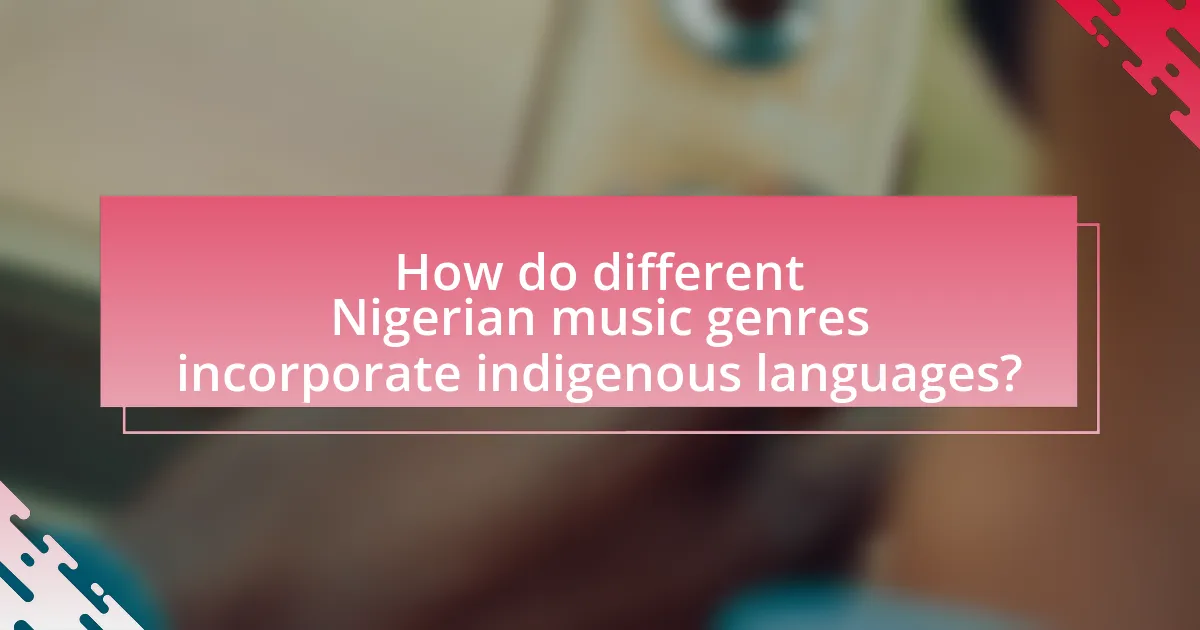
How do different Nigerian music genres incorporate indigenous languages?
Different Nigerian music genres incorporate indigenous languages by using local dialects and expressions in their lyrics, which reflect cultural identity and heritage. For instance, Afrobeat often features Yoruba and Pidgin English, allowing artists like Fela Kuti to convey social and political messages rooted in Nigerian culture. Similarly, Highlife music predominantly utilizes Igbo and Efik languages, showcasing traditional storytelling and communal values. Additionally, genres like Fuji and Juju music heavily rely on Yoruba language, emphasizing oral traditions and proverbs that resonate with local audiences. This linguistic integration not only preserves indigenous languages but also enhances the authenticity and relatability of the music within Nigerian society.
What are the primary music genres in Nigeria that utilize indigenous languages?
The primary music genres in Nigeria that utilize indigenous languages are Afrobeat, Highlife, Juju, and Fuji. Afrobeat, popularized by Fela Kuti, incorporates Yoruba and other indigenous languages in its lyrics, reflecting social and political themes. Highlife, originating from the Igbo and Efik cultures, often features lyrics in Igbo and Pidgin English, celebrating local traditions and lifestyles. Juju music, rooted in Yoruba culture, prominently uses the Yoruba language to convey messages of love, spirituality, and social commentary. Fuji, which evolved from traditional Yoruba music, also employs Yoruba language in its lyrics, focusing on themes of everyday life and cultural identity. These genres not only showcase Nigeria’s rich linguistic diversity but also serve as vehicles for cultural expression and social commentary.
How does Afrobeat integrate indigenous languages into its lyrics?
Afrobeat integrates indigenous languages into its lyrics by incorporating local dialects and expressions that resonate with the cultural identity of its audience. This practice enhances the authenticity of the music and allows for deeper emotional connections with listeners. For instance, artists like Fela Kuti often used Yoruba, a prominent indigenous language in Nigeria, to convey messages about social issues, spirituality, and cultural pride. The use of indigenous languages not only reflects the rich linguistic diversity of Nigeria but also serves to preserve and promote these languages within contemporary music.
What role do indigenous languages play in traditional folk music?
Indigenous languages serve as a vital medium for expressing cultural identity and heritage in traditional folk music. They encapsulate the unique stories, beliefs, and values of communities, allowing for the preservation of oral traditions and historical narratives. For instance, in Nigeria, languages such as Yoruba, Igbo, and Hausa are integral to folk songs, which often convey moral lessons, social commentary, and communal experiences. The use of indigenous languages in these musical forms not only fosters a sense of belonging but also enhances the emotional resonance of the music, making it more relatable to the local audience.
How do regional variations affect the use of indigenous languages in music?
Regional variations significantly influence the use of indigenous languages in music by shaping the linguistic diversity and cultural expressions found in different areas. In Nigeria, for example, the presence of over 500 indigenous languages leads to distinct musical styles that incorporate local dialects, reflecting the unique cultural identities of various ethnic groups. This linguistic diversity is evident in genres such as Afrobeat, Highlife, and Juju, where artists often use their native languages to convey messages, tell stories, and connect with their audiences. Furthermore, regional variations can affect the popularity and accessibility of certain languages in music, as artists may choose to sing in more widely spoken languages to reach broader audiences, while still preserving local dialects in specific contexts. This dynamic interplay between language and music highlights the importance of regional identity in the artistic expression of indigenous cultures.
What are the distinct features of indigenous languages in Northern Nigerian music?
Indigenous languages in Northern Nigerian music exhibit distinct features such as tonal variations, rich oral traditions, and the use of proverbs and metaphors. These languages, including Hausa, Fulfulde, and Kanuri, incorporate specific tonal inflections that influence melody and rhythm, creating a unique sound. Additionally, the oral tradition prevalent in these cultures emphasizes storytelling and communal values, often reflected in song lyrics. Proverbs and metaphors are frequently employed to convey deeper meanings and cultural significance, enhancing the listener’s experience and connection to the music. This linguistic richness not only preserves cultural identity but also fosters a sense of community among listeners and performers.
How do Southern Nigerian music genres differ in their use of indigenous languages?
Southern Nigerian music genres, such as Highlife, Juju, and Afrobeat, differ significantly in their use of indigenous languages, with each genre reflecting the linguistic diversity of the region. Highlife predominantly incorporates Igbo and Efik languages, emphasizing local narratives and cultural themes, while Juju music primarily utilizes Yoruba, showcasing traditional proverbs and storytelling. Afrobeat, on the other hand, often blends English with indigenous languages, creating a fusion that appeals to both local and international audiences. This linguistic variation not only enhances the cultural authenticity of the music but also serves to engage listeners by resonating with their linguistic identities and experiences.
What impact do collaborations have on the use of indigenous languages in music?
Collaborations significantly enhance the use of indigenous languages in music by increasing visibility and accessibility. When artists from different backgrounds collaborate, they often incorporate indigenous languages into their work, which helps to promote these languages to broader audiences. For instance, collaborations between mainstream artists and indigenous musicians can lead to the inclusion of local dialects in popular songs, thereby revitalizing interest in these languages. Research indicates that such partnerships not only preserve linguistic heritage but also foster cultural exchange, as seen in the Nigerian music scene where artists like Burna Boy and Wizkid have integrated indigenous languages into their lyrics, resulting in international recognition and appreciation.
How do collaborations between artists from different genres influence language use?
Collaborations between artists from different genres significantly influence language use by blending linguistic styles and introducing new vocabulary. For instance, when a hip-hop artist collaborates with a traditional folk musician, the resulting work often incorporates elements of both genres, leading to the fusion of contemporary slang with indigenous phrases. This phenomenon can be observed in Nigerian music, where artists like Burna Boy and Wizkid have integrated Yoruba and Pidgin English into their lyrics, enhancing the accessibility and relatability of their music to diverse audiences. Such collaborations not only enrich the linguistic landscape but also promote cultural exchange, as seen in the rise of Afrobeat, which combines African rhythms with global music trends, thereby expanding the use of indigenous languages in mainstream music.
What are some notable examples of successful collaborations that highlight indigenous languages?
Notable examples of successful collaborations that highlight indigenous languages in Nigerian music include the partnership between Nigerian artist Burna Boy and the South African group Major Lazer, which features indigenous languages like Yoruba and Zulu in their music. Another example is the collaboration between Tiwa Savage and the Nigerian artist Wizkid, where they incorporate Yoruba language into their lyrics, showcasing cultural heritage. Additionally, the song “Jerusalema” by Master KG, featuring Nomcebo Zikode, has gained international acclaim while prominently featuring indigenous South African languages, demonstrating the global appeal of music rooted in local languages. These collaborations not only promote indigenous languages but also enhance cultural exchange and appreciation on a global scale.
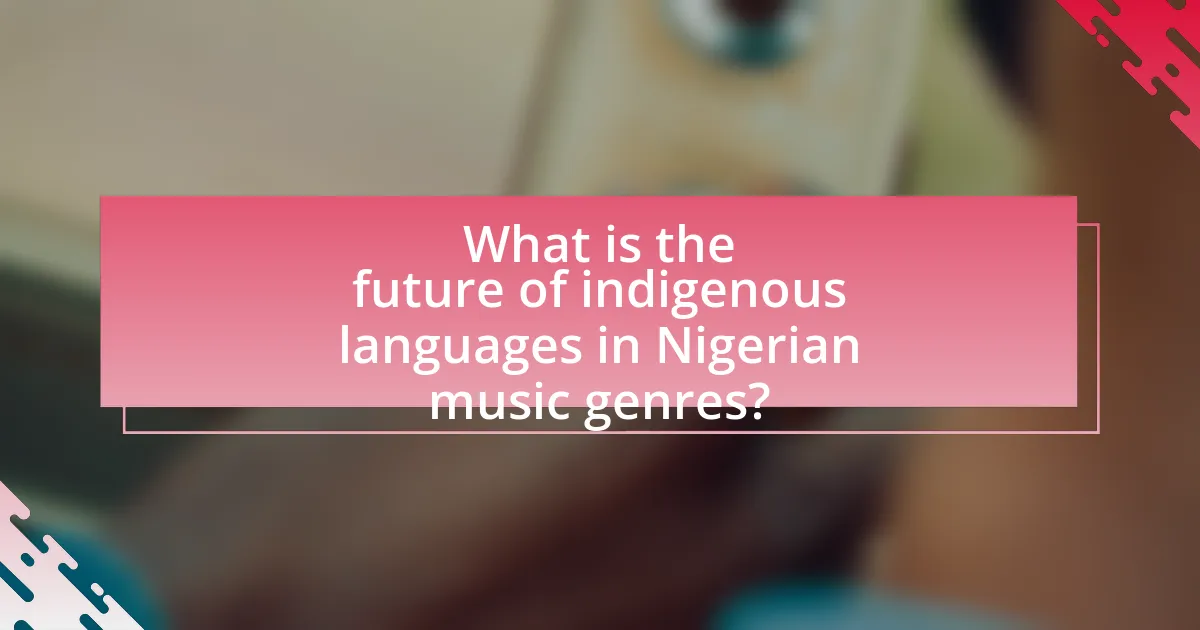
What is the future of indigenous languages in Nigerian music genres?
The future of indigenous languages in Nigerian music genres appears promising, as there is a growing trend among artists to incorporate local languages into their music. This resurgence is driven by a cultural renaissance that values authenticity and heritage, with artists like Burna Boy and Wizkid often using Yoruba and Pidgin English in their lyrics, which resonates with both local and international audiences. Additionally, the Nigerian music industry has seen increased support for indigenous languages through platforms like social media and streaming services, which facilitate the global reach of music in local dialects. This trend is further supported by the Nigerian government’s initiatives to promote cultural heritage, ensuring that indigenous languages remain relevant in contemporary music.
How can technology support the use of indigenous languages in music?
Technology can support the use of indigenous languages in music by providing platforms for recording, distributing, and promoting music that features these languages. Digital audio workstations and software enable artists to create high-quality recordings in their native languages, while streaming services and social media facilitate wider reach and audience engagement. For instance, platforms like YouTube and Spotify allow musicians to share their work globally, increasing visibility for indigenous languages. Additionally, mobile applications can offer language learning tools and resources, helping to preserve and promote these languages through music. This integration of technology not only enhances the accessibility of indigenous music but also fosters cultural pride and identity among speakers.
What platforms are emerging to promote indigenous language music?
Emerging platforms promoting indigenous language music include digital streaming services like Spotify and Apple Music, which have introduced curated playlists featuring indigenous artists. Additionally, social media platforms such as Instagram and TikTok facilitate the sharing of indigenous music, allowing artists to reach wider audiences. Community-driven platforms like Bandcamp also support indigenous musicians by enabling them to sell their music directly to fans. These platforms are increasingly recognizing the cultural significance of indigenous languages, thus providing a space for their promotion and preservation.
How can social media influence the popularity of indigenous language songs?
Social media can significantly enhance the popularity of indigenous language songs by providing a platform for wider dissemination and engagement. Through platforms like Instagram, TikTok, and YouTube, artists can share their music with global audiences, leading to increased visibility and potential virality. For instance, viral challenges or trends often incorporate indigenous songs, which can introduce these languages to listeners who may not have encountered them otherwise. Additionally, social media allows for direct interaction between artists and fans, fostering a community that supports and promotes indigenous music. This phenomenon is evidenced by the rise of Nigerian artists who have gained international recognition through social media, showcasing the effectiveness of these platforms in elevating indigenous language songs.
What role do educational initiatives play in promoting indigenous languages through music?
Educational initiatives play a crucial role in promoting indigenous languages through music by providing structured platforms for learning and cultural exchange. These initiatives often incorporate music as a pedagogical tool, enabling learners to engage with the language in a dynamic and enjoyable manner. For instance, programs that integrate traditional songs into the curriculum not only teach vocabulary and grammar but also instill cultural pride and identity among students. Research has shown that music enhances memory retention, making it an effective medium for language acquisition. Furthermore, initiatives that involve community participation, such as workshops and performances, foster intergenerational transmission of language and culture, ensuring that indigenous languages remain vibrant and relevant in contemporary society.
How can schools incorporate indigenous languages into music education?
Schools can incorporate indigenous languages into music education by integrating traditional songs and musical practices that utilize these languages into the curriculum. This approach not only preserves cultural heritage but also enhances students’ linguistic skills and cultural awareness. For instance, using songs in Yoruba, Igbo, or Hausa can help students learn vocabulary and grammar in a contextual setting, making language acquisition more engaging. Research shows that music education that includes indigenous languages fosters a deeper connection to cultural identity and promotes inclusivity in the classroom, as evidenced by programs in Nigeria that have successfully integrated local languages into music curricula, resulting in increased student participation and interest in their cultural roots.
What community programs exist to support indigenous language music initiatives?
Community programs that support indigenous language music initiatives include the Nigerian Indigenous Music and Arts Foundation, which promotes the preservation and performance of traditional music in local languages. Additionally, the National Council for Arts and Culture in Nigeria provides funding and resources for projects that encourage the use of indigenous languages in music. These programs aim to enhance cultural heritage and ensure the transmission of indigenous languages through musical expression, thereby fostering community engagement and cultural pride.
What practical steps can artists take to promote indigenous languages in their music?
Artists can promote indigenous languages in their music by incorporating native lyrics, collaborating with indigenous language speakers, and utilizing traditional instruments. By writing songs in indigenous languages, artists can preserve and revitalize these languages, making them accessible to wider audiences. Collaborations with native speakers can enhance authenticity and provide cultural context, while the use of traditional instruments can create a distinctive sound that resonates with cultural heritage. Research indicates that music is a powerful tool for language preservation, as seen in the work of artists like Burna Boy, who blends indigenous languages with contemporary genres, thus fostering appreciation and awareness of Nigeria’s linguistic diversity.
